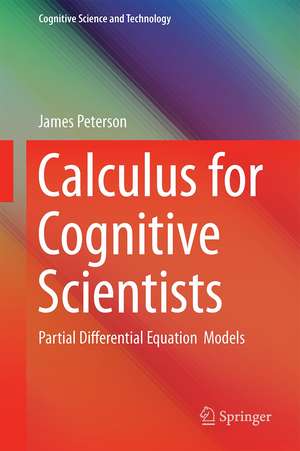Calculus for Cognitive Scientists: Partial Differential Equation Models: Cognitive Science and Technology
Autor James Petersonen Limba Engleză Hardback – 19 feb 2016
| Toate formatele și edițiile | Preț | Express |
|---|---|---|
| Paperback (1) | 1000.38 lei 6-8 săpt. | |
| Springer Nature Singapore – 9 dec 2018 | 1000.38 lei 6-8 săpt. | |
| Hardback (1) | 1006.95 lei 6-8 săpt. | |
| Springer Nature Singapore – 19 feb 2016 | 1006.95 lei 6-8 săpt. |
Din seria Cognitive Science and Technology
- 20%
 Preț: 903.48 lei
Preț: 903.48 lei - 20%
 Preț: 645.14 lei
Preț: 645.14 lei - 20%
 Preț: 958.20 lei
Preț: 958.20 lei - 20%
 Preț: 653.21 lei
Preț: 653.21 lei - 20%
 Preț: 1173.28 lei
Preț: 1173.28 lei - 20%
 Preț: 1008.95 lei
Preț: 1008.95 lei - 20%
 Preț: 1005.46 lei
Preț: 1005.46 lei - 20%
 Preț: 760.14 lei
Preț: 760.14 lei - 5%
 Preț: 1102.10 lei
Preț: 1102.10 lei - 20%
 Preț: 813.93 lei
Preț: 813.93 lei - 20%
 Preț: 586.86 lei
Preț: 586.86 lei - 20%
 Preț: 978.76 lei
Preț: 978.76 lei - 20%
 Preț: 811.45 lei
Preț: 811.45 lei - 20%
 Preț: 1634.78 lei
Preț: 1634.78 lei - 20%
 Preț: 773.59 lei
Preț: 773.59 lei - 20%
 Preț: 1914.38 lei
Preț: 1914.38 lei
Preț: 1006.95 lei
Preț vechi: 1258.69 lei
-20% Nou
Puncte Express: 1510
Preț estimativ în valută:
192.69€ • 206.04$ • 160.65£
192.69€ • 206.04$ • 160.65£
Carte tipărită la comandă
Livrare economică 18 aprilie-02 mai
Preluare comenzi: 021 569.72.76
Specificații
ISBN-13: 9789812878786
ISBN-10: 9812878785
Pagini: 500
Ilustrații: XXXI, 534 p. 156 illus. in color.
Dimensiuni: 155 x 235 x 32 mm
Greutate: 0.97 kg
Ediția:1st ed. 2016
Editura: Springer Nature Singapore
Colecția Springer
Seria Cognitive Science and Technology
Locul publicării:Singapore, Singapore
ISBN-10: 9812878785
Pagini: 500
Ilustrații: XXXI, 534 p. 156 illus. in color.
Dimensiuni: 155 x 235 x 32 mm
Greutate: 0.97 kg
Ediția:1st ed. 2016
Editura: Springer Nature Singapore
Colecția Springer
Seria Cognitive Science and Technology
Locul publicării:Singapore, Singapore
Public țintă
ResearchCuprins
Introduction.- Graham - Schmidt Orthogonalization.- Numerical Differential Equations.- Biological Molecules.- Ion Movement.- Lumped and Distributed Cell Models.- Time Independent Solutions to Infinite Cables.- Time Independent Solutions to Finite and Half-Infinite Space Cables.- A Primer On Series Solutions.- Linear Partial Differential Equations.- Simplified Dendrite - Soma – Axon Information Processing.- The Basic Hodgkin - Huxley Model.- Final Thoughts.- Background Reading.
Notă biografică
Dr. James Peterson is an Associate Professor in Mathematical Sciences and Biological Sciences at Clemson University, USA. His formal training is in mathematics but he has worked as an aerospace engineer and a software engineer also. He enjoys working on very hard problems that require multiple disciplines to make sense out of and he reads, studies and plays in cutting edge areas a lot as part of his interests.
Textul de pe ultima copertă
This book shows cognitive scientists in training how mathematics, computer science and science can be usefully and seamlessly intertwined. It is a follow-up to the first two volumes on mathematics for cognitive scientists, and includes the mathematics and computational tools needed to understand how to compute the terms in the Fourier series expansions that solve the cable equation. The latter is derived from first principles by going back to cellular biology and the relevant biophysics. A detailed discussion of ion movement through cellular membranes, and an explanation of how the equations that govern such ion movement leading to the standard transient cable equation are included. There are also solutions for the cable model using separation of variables, as well an explanation of why Fourier series converge and a description of the implementation of MatLab tools to compute the solutions. Finally, the standard Hodgkin - Huxley model is developed for an excitable neuron and is solved using MatLab.
Caracteristici
Derives the cable equation and the Hodgkin Huxley models for excitatory neurons from first principles of biophysics Highlights theoretical and computational tools to enhance understanding of both the underlying science and the solutions Provides insights into the theory and computation of the underlying cognitive and biological science models that are studied Includes supplementary material: sn.pub/extras

















